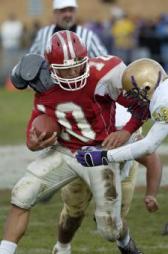 Increasing stride frequency is performed by moving the ground leg through the same range of motion faster than normal (coaches roundtable). This is the basis of overspeed training. Overspeed training can be performed in a variety of manners including assisted running on a treadmill, downhill running, or towing (Essentials of S & C p. 403-415).
Increasing stride frequency is performed by moving the ground leg through the same range of motion faster than normal (coaches roundtable). This is the basis of overspeed training. Overspeed training can be performed in a variety of manners including assisted running on a treadmill, downhill running, or towing (Essentials of S & C p. 403-415).
“Upgrade Your Operating System”
Improvements are largely due to neuromuscular factors; increasing the rate of firing for the musculature responsible moving the legs through the running cycle more quickly.
Think of the nervous system as the software of your body. If it is slow and inefficient, your movements will be slow and inefficient.
A great deal of time is usually spent focusing on the hip flexors, as they are primarily responsible for decreasing time spent in the recovery phase of the running cycle.
As with power development, following the initial adaptation of the nervous system, more permanent muscular changes will take affect (Hammett/Hey).
“Breaking Tradition”
If we look at traditional means of overspeed training, the two most common methods include tow training and downhill running.
Downhill running can be effective, when performed under close supervision with the right athlete and on the right elevation. Unfortunately, most athletes have a very unusual running gait when performing such an exercise.
Athletes tend to heel strike unnaturally which will increase braking forces and promote poor mechanics (Essentials of S. & C. ). Also, many athletes experience a great deal of Delayed Onset Muscle Soreness (DOMS) following downhill workouts due to its eccentric nature.
Research tells us that increases in DOMS will decrease running efficiency and power output. Because of this, most recommend 2-5 days of recovery following the onset of DOMS (Smith). For most athletes, this is a waste of valuable training time.
Unfortunately, tow training doesn’t offer much of an alternative. Research shows a decrease in running kinematics while an athlete is being towed (Corn/Knudson).
When working with young athletes, running mechanics MUST be a prime concern.
“A Problem Solver”
The high speed treadmill can solve a great deal of the above concerns.
By spotting the athlete appropriately; keeping the pelvis in a neutral position and cuing the athlete to maintain knee drive, the athlete can be placed in a safe, appropriate environment which forces the legs to cycle at a higher rate than normal.
This is especially true of spotting an athlete while running at elevation. Caldwell and Swanson confirmed this by showing that running on a treadmill at elevation forces the athlete to spend a greater time in stance than at flat, which in turn requires the legs to move through the recovery phase at a higher rate than normal.



Leave a Reply